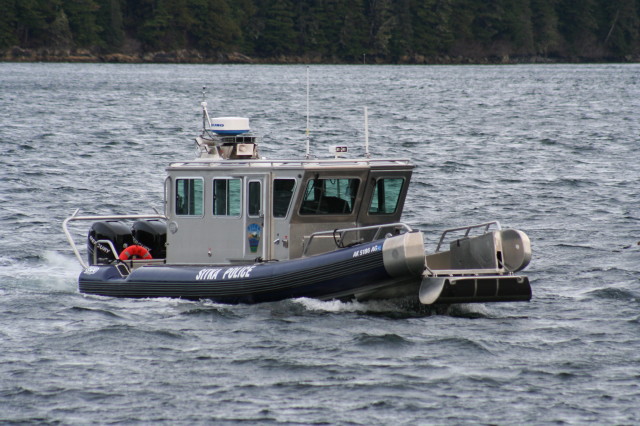
Sitka’s ERV is a SAFE Boat design favored by the Coast Guard and other agencies. (Don Kluting photo)
Every year Sitka has its share of maritime emergencies and remote rescue operations. Last December, for example, two hunters were seriously injured in Salisbury Sound when their boat slammed into a cliff in the narrows. And while that and other events often make headlines, you don’t often hear about the state-of-the-art Emergency Response Vessel Sitka has available to render aid.
That’s because, in many cases, the $200,000 boat has remained tied up at the dock, while responders take the harbor skiff — or even their own private boats — to the scene of emergencies.
The controversy over Sitka’s eight-year-old Emergency Response Vessel has been going on for well… about eight years. The ERV was purchased with a grant from the US Department of Homeland Security, and it was designed to accommodate law enforcement, fire, and rescue operations.
The boat has been in the care of the Police Department until now, and reasons for tension over the boat are as diverse as the people responsible for serving these three vital missions. If there is any consensus at all around the boat, it’s that it is not being utilized to its fullest.
At the last meeting of the Sitka assembly on January 14, administrator Mark Gorman suggested that his department heads had charted a new course for the ERV.
“And we are going to look at moving the vessel under the responsibility of the Harbor Department. And it will be dispatched and scheduled out of the Fire Department. And the rationale behind this is to allow better access to other departments the use of the vessel. In particular, Search and Rescue.”
Sitka Search and Rescue director Don Kluting has the numbers to support this idea. “In 2013 we had a total of 54 missions, and of those, 21 required the use of a vessel.”
21 missions is a lot, and no two missions are ever the same. SAR is on the water a lot more than you might think.
“For either transport to a remote location so we can do ground search, or out there providing mutual aid service to the Coast Guard: towing boats and rescuing vessels that are in distress.”
Kluting says that the fewest number of missions SAR has done on the water in any year in the last decade or so is 14. Whether by design or default, SAR has become the go-to organization for this kind of work.
And the boat they take is usually not the ERV.
“So at this point we’re using the Harbor Department boat. The harbormaster and his staff have been wonderful to work with. When the call comes in, we make one call to the on-duty harbor person or the harbormaster and get permission to utilize their vessel.”
Having that kind of ready-access for the Emergency Response Vessel is where Sitka’s administration wants to go. The harbor skiff is a 28-foot aluminum drop bow, with a partial cabin. Depending on ocean conditions, its use can be very limited. The ERV is 30-feet, and its manufacturer, SAFE Boat, is favored by the Coast Guard and other agencies. It’s rated for a sea state of “5,” which means 25-knot winds and 12-foot seas. It also can transport its crew and two patients in litters inside the fully-enclosed cabin.
The sticky part is the Homeland Security grant which purchased the ERV.
This is police chief Sheldon Schmitt talking to the assembly about it in 2008.
“The primary purpose for the boat has been law enforcement. It’s a Homeland Security boat. We’re not using it for patrol. We’ve gone out approximately 125 times with the boat in the two years that we’ve been tasked with maintaining and operating it.”
Schmitt told the assembly at the time that the Department of Homeland Security did not require the ERV to be housed within the Police Department — only that it be available to serve a law enforcement function. He also said that, of those 125 uses of the boat, only six had been for search and rescue.
In an interview with KCAW last week, Schmitt said he is in favor of the administration’s efforts to make the ERV more accessible by transferring it to the Harbor Department, but that law enforcement will have to remain involved at some level to satisfy the terms of the Homeland Security Grant.
“It’s worth trying,” he said.
Both Schmitt and Kluting acknowledge the important role of the Harbor Department in making headway on the problem. Maintaining the ERV is a considerable responsibility. Six of Search and Rescue’s 44-member team are trained boat operators, and they’ll have to do even more training to make this idea a reality. Kluting knows he’s not just being handed the keys.
“You just don’t jump in a boat and go.”
Administrator Mark Gorman told the assembly on January 14 that the transfer of the Emergency Response Vessel to harbors could take a couple of months.































